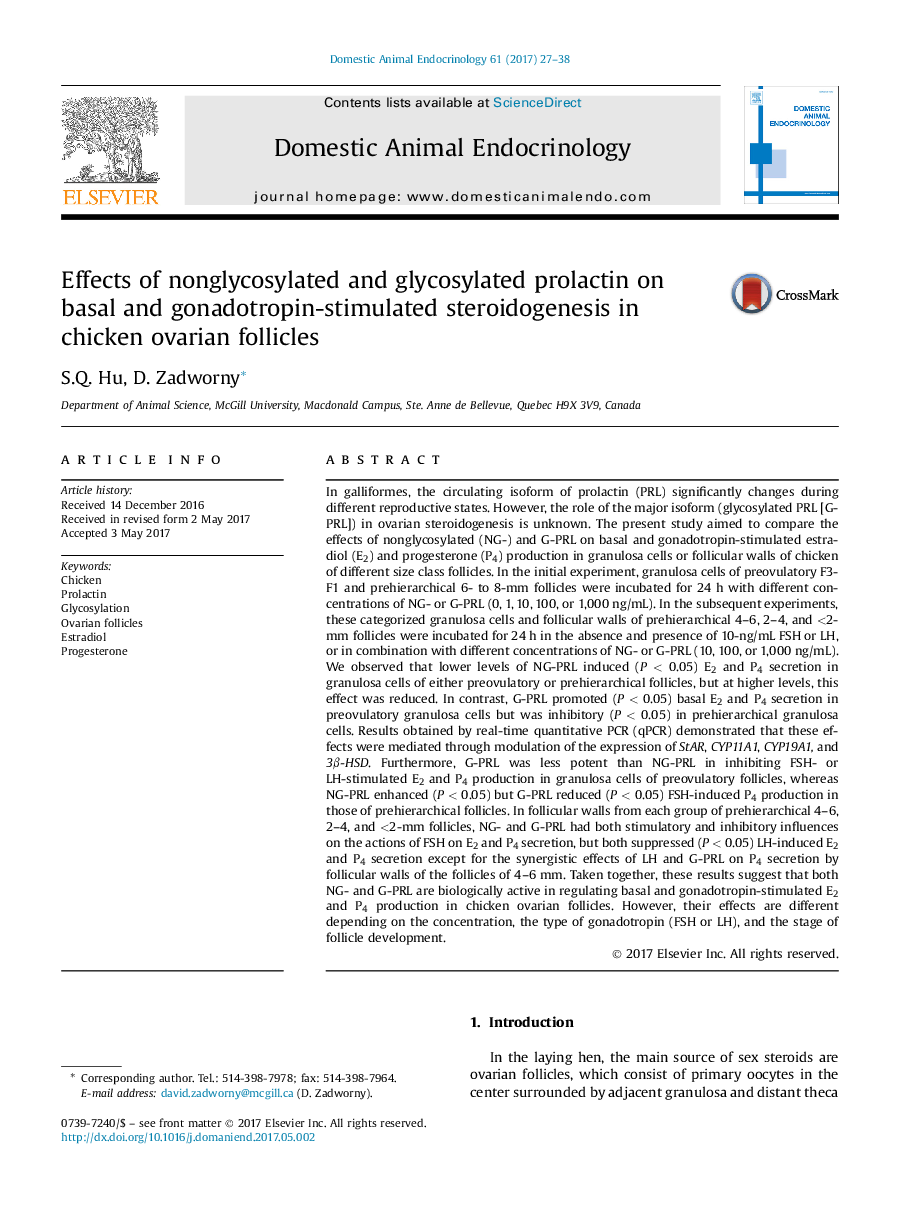| کد مقاله | کد نشریه | سال انتشار | مقاله انگلیسی | نسخه تمام متن |
|---|---|---|---|---|
| 5535337 | 1551498 | 2017 | 12 صفحه PDF | دانلود رایگان |
- Both prolactin isoforms affect steroid secretion by chicken ovarian follicles.
- These effects are mediated via regulation of StAR, CYP11A1, CYP19A1 and 3β-HSD.
- Differential effects depend on the dose, follicular size and gonadotropin type.
In galliformes, the circulating isoform of prolactin (PRL) significantly changes during different reproductive states. However, the role of the major isoform (glycosylated PRL [G-PRL]) in ovarian steroidogenesis is unknown. The present study aimed to compare the effects of nonglycosylated (NG-) and G-PRL on basal and gonadotropin-stimulated estradiol (E2) and progesterone (P4) production in granulosa cells or follicular walls of chicken of different size class follicles. In the initial experiment, granulosa cells of preovulatory F3-F1 and prehierarchical 6- to 8-mm follicles were incubated for 24 h with different concentrations of NG- or G-PRL (0, 1, 10, 100, or 1,000 ng/mL). In the subsequent experiments, these categorized granulosa cells and follicular walls of prehierarchical 4-6, 2-4, and <2-mm follicles were incubated for 24 h in the absence and presence of 10-ng/mL FSH or LH, or in combination with different concentrations of NG- or G-PRL (10, 100, or 1,000 ng/mL). We observed that lower levels of NG-PRL induced (P < 0.05) E2 and P4 secretion in granulosa cells of either preovulatory or prehierarchical follicles, but at higher levels, this effect was reduced. In contrast, G-PRL promoted (P < 0.05) basal E2 and P4 secretion in preovulatory granulosa cells but was inhibitory (P < 0.05) in prehierarchical granulosa cells. Results obtained by real-time quantitative PCR (qPCR) demonstrated that these effects were mediated through modulation of the expression of StAR, CYP11A1, CYP19A1, and 3β-HSD. Furthermore, G-PRL was less potent than NG-PRL in inhibiting FSH- or LH-stimulated E2 and P4 production in granulosa cells of preovulatory follicles, whereas NG-PRL enhanced (P < 0.05) but G-PRL reduced (P < 0.05) FSH-induced P4 production in those of prehierarchical follicles. In follicular walls from each group of prehierarchical 4-6, 2-4, and <2-mm follicles, NG- and G-PRL had both stimulatory and inhibitory influences on the actions of FSH on E2 and P4 secretion, but both suppressed (P < 0.05) LH-induced E2 and P4 secretion except for the synergistic effects of LH and G-PRL on P4 secretion by follicular walls of the follicles of 4-6 mm. Taken together, these results suggest that both NG- and G-PRL are biologically active in regulating basal and gonadotropin-stimulated E2 and P4 production in chicken ovarian follicles. However, their effects are different depending on the concentration, the type of gonadotropin (FSH or LH), and the stage of follicle development.
Journal: Domestic Animal Endocrinology - Volume 61, October 2017, Pages 27-38
